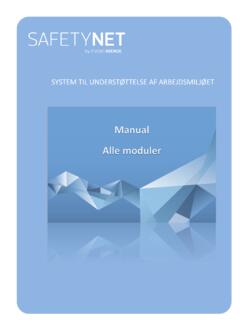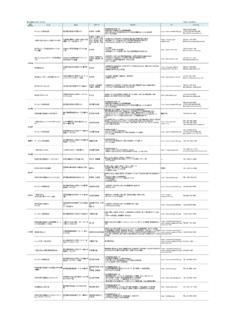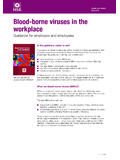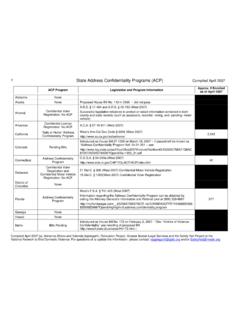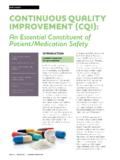Transcription of A Guide for Community Pharmacies - safetynetrx.ca
1 0 A Guide for Community Pharmacies CONTINUOUS QUALITY ASSURANCE 2 0 1 1 S a f e t y N E T-Rx 1 TABLE OF CONTENTS INTRODUCTION HOW TO USE THIS CQA STANDARD AND RESOURCE TEMPLATE FORMS SCHEDULE OF QRE QUARTERLY MEETING QRE QUARTERLY MEETING REPORT QRE QUARTERLY MEETING ACTION PLAN ANNUAL MSSA IMPROVEMENT PLAN CQA SUMMARIZATION SCHEDULE OF AUDITS RESOURCES AND REFERENCES ROOT CAUSE ANALYSIS FISHBONE SAMPLE CONFIDENTIALITY SUGGESTED PROTOCOL FOR HANDLING CANADIAN DISCLOSURE NOVA SCOTIA APOLOGY 2 DI SCL A I ME R The information contained in this Guide is intended to serve as a reference for informational purposes only.
2 It is not intended as a complete Guide to continuous quality assurance as set forth by the Nova Scotia College of Pharmacists (NSCP). This information is intended for use by pharmacy staff within the scope and standards of their professional practice. Having this information does not ensure that you comply with the Continuous Quality Assurance Standards for Community Pharmacies ; staff must be actively engaged in the quality assurance process to be in compliance. The authors cannot be held responsible for the continued currency of the information or for any errors or omissions in the Guide for any consequences in the form of liability, loss or direct/indirect damage. Authors: Andrea Scobie, Dalhousie University Neil MacKinnon, Dalhousie University Todd Boyle, St. Francis Xavier University Bev Zwicker, Nova Scotia College of Pharmacists Tom Mahaffey, St.
3 Francis Xavier University The authors would like to thank Kellie Duggan and Joanne McNair for their contributions to the final Guide . If you have any questions regarding the content of this Guide , please email the research team at Funding for this project was supplied by the Canadian Foundation for Pharmacy Innovation Fund. 3 ISMP maintains a national QRE aggregate database and reports on identified trends and patterns. HOW TO USE THIS Guide It is recommended that you thoroughly acquaint yourself with the contents of this assessment Guide . The documents included in this Guide have been selected to help you better understand the Continuous Quality Assurance (CQA) standards as set forth by the Nova Scotia College of Pharmacists (NSCP).
4 Once you have read through the Guide , we encourage you to sit down with staff members to review the documents and to discuss how best to implement the CQA standards in your store. Below is the Continuous Quality Improvement (CQI) Cycle for Community Pharmacists (Figure 1). This provides a visual description of the process by which the standards and their associated practices should be integrated into your pharmacy practice. Its purpose is to help you better understand when and how to use the forms included in this Guide . Figure 1. CQI Cycle for Community Pharmacies 4 Documents included in this binder are for your reference and use include: A copy of the Continuous Quality Assurance Standards in Community Pharmacies has been included in this Guide for your review.
5 These are the standards by which you and your pharmacy will be inspected by the NSCP. All Nova Scotia Community Pharmacies were required to have a CQA program that complies with these standards, in place effective November 1, 2010. Institute for Safe Medication Practices (ISMP) Canada resources which provide assistance in helping to meet the standards have also been included. A sample QRE Quarterly Meeting Agenda has been included to help CQA coordinators and pharmacy managers conduct quarterly staff meetings. By following a standard agenda, quarterly meetings should address the same content and provide staff members with a predictable, structured flow. Time is allocated for review of old business, review of new quality related events (QREs), and announcements to staff. At the end of each meeting, a tentative date for the next meeting should be set by all in attendance.
6 It is important that the improvement plan is reviewed and amended as needed at each meeting. The QRE Quarterly Meeting Report Form should be filled out for each quarterly meeting. The form encourages discussion and analysis of QREs based on a number of dimensions, including workflow, staffing and environment issues. The creation of action plans in each of these areas assist in the effort to reduce the likelihood of the QRE reoccurring. These forms also aide in the discussion of old business during quarterly QRE meetings to ensure follow through on the action plans. The CQA Summarization Document will be used by the inspectors to help assure the pharmacy has achieved the standards of practice. The document is also useful to provide a self-audit for Pharmacies nearing their inspection date.
7 Please ensure that this document is filled out completely and accurately. It can be useful to fill this document out monthly to help keep track of the number of QREs reported and when quarterly meetings take place. FAQs have been provided as a quick reference on a number of topics related to the CQA standards. Additional documents included in this Guide are intended as resources to aide Pharmacies in topics related to the CQA standards. Root Cause Analysis Instructions provide Pharmacies with directions on how to employ root cause analysis techniques when analyzing QREs during quarterly 5 and staff meetings. A Fishbone Diagram is also included to help staff visually discuss root causes and identify solutions.
8 A sample Confidentiality Agreement has been included to aide in adhering to confidentiality provisions as stated in Standard #7. The Suggested Protocol for Handling Medication Errors provides an easy-to-follow policy when a QRE that has reached the patient has occurred or is suspected to have occurred in the dispensary. The protocol is generic enough to use in all instances where a QRE has reached a patient and provides direct advice on how to proceed. This protocol should be placed on a shared notice space for all pharmacists, pharmacy techs and locum staff to view and reference. The Canadian Disclosure Guidelines, compiled by the Canadian Patient Safety Institute (CPSI), provide guidance on how best to disclose QREs to patients who have been impacted. This document is meant as a guideline only, and Pharmacies are encouraged to discuss the procedures in place in their pharmacy for disclosure to patients.
9 Finally, the Nova Scotia Apology Act is to serve as a reference when preparing for disclosure. 6 7 8 9 CQA FREQUENTLY ASKED QUESTIONS (FAQS) What is a Quality Related Event (QRE)? As defined in the NSCP Standards of Practice for Quality Assurance in Community Pharmacies , QREs include errors that reach the patient as well as those that are intercepted prior to dispensing.
10 Do all QREs need to be reported? As stated in the NSCP Standards of Practice for Quality Assurance in Community Pharmacies , The extent to which intercepted errors are reported will be a professional judgment decision of the pharmacy manager in consideration of the nature of the intercepted error, its implication for patient safety, and the extent to which it is reoccurring. However, as per Standard #2, all medication errors that reach a patient must be recorded both anonymously online, as well as fully and identifiably within readily retrievable records in the pharmacy. What is a coordinator? As part of SafetyNET-Rx, each store will ideally select at least two in-store coordinators, preferably one pharmacist and one pharmacy technician. These coordinators will be responsible for training their staff by creating an open dialogue on QREs and introducing the SafetyNET-Rx program.
